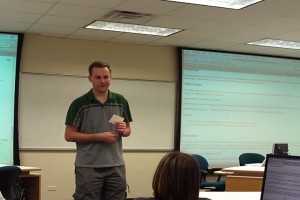It’s hard to believe that two weeks have truly passed since I last wrote. That’s two weekends, four lectures and one lab I’ve given, a small conference, and one big storm.
On Friday, September 5, I talked about generics and wildcards in my COMP 202 lecture. In the end, I unfortunately had a problem describing lower-bound wildcards. I couldn’t show the contravariant relationship. I corrected that on Monday. I noticed that there’s a big difference between being able to use wildcards and being able to clearly explain them.
Right after the COMP 617 seminar, Walid, Hashim, Jun, Cherif, Angela and I left for Abilene, TX to attend the Middle Earth Programming Languages Seminar. Walid did most of the seven-hour drive in both directions, but I somehow ended up doing most of the navigating, even though I was sitting in the left third-row seat. That sometimes made it hard to hear. Next time, if I navigate, I’ll want to sit closer. I also had some trouble with my allergies and my contacts during the trip — my eyes were getting really dry towards the end of the trip, but all in all the trip was fun. On Friday night, we watched a production of “Moonlight and Magnolias” at Abilene Christian University, and it was simply amazing. That’s one of the reasons why “Gone With The Wind” is in the title of this post.
The trip, and returning just before midnight on Saturday, did take a bit of energy out of me, though, so I had a hard time to get my part of COMP 202 homework #1 graded. Fortunately, the grading went well, thanks to our TA. On Monday, I corrected my mistake about wildcards from Friday, and then started talking about generic lists and algorithms on them.
We also had a lab on Monday so we could help the students with the GUI side of the Hangman game. Our TA was there, but I was a little disappointed about his knowledge of the assignment and Java. Dr. Wong and I plan to get him more involved and ultimately responsible for teaching the labs (as it should be), but this will be difficult.
On Wednesday, we finished talking about lists, and then started using some operations, like getting the first, removing the first, removing the rest, and removing the last x elements of a list to discuss how expensive these operations were. I didn’t quite introduce big-oh notation yet, but we generalized the number of operations to lists of length n. We still had a bit of an argument about which operations should count, so our counts were usually n, 2n, 3n, etc. It was a good discussion. Sadly, the video camera ran out of battery on this day.
On Friday I wanted to formalize this and introduce big-oh notation fully, but on Friday and Monday classes were canceled because of hurricane Ike — the other reason why “Gone With The Wind” is in the title, but more about that later. That made us lose two lectures and got the schedule in a bit of trouble. Today, I moved the exam and homework assignments around a bit. The university ruled that no assignments should be due this week, so I had to move homework #2 to next Monday. But in order to keep lectures and assignments together, I had to move them anyway.
In class today, only half of the students were there; I assume the others evacuated and hope they will be back soon. We finished talking about big-oh notation, and we cleared up why the constant factor in counting didn’t matter.
These entire two week seem like a blur, though, thanks to hurricane Ike. Starting late last Wednesday. we pretty much knew that this would be a close one. I went out to buy some more supplies on Wednesday night already. Some time on Thursday, a notice went out that classes are cancelled on Friday. After work on Thursday and early on Friday, I prepared my apartment for the storm: I taped cardboard covered in plastic bags to my windows again, a ghetto replacement for plywood. I know it couldn’t protect the window, but it should keep shards of glass out and give me a few more minutes to save valuable items. Then came the big wait.
The wind started getting pretty bad around 11 PM on Friday, but I went to bed at 2 AM, around the time “the Eyke” (the eye of Ike, as one newscaster accidentally called it) made landfall just east of Galveston, as a strong category 2 hurricane, just a couple of miles short of category 3. I woke up again at 2:30 AM when my UPSes started beeping. I had lost power. I quickly saved and and copied some files, then shut everything down. It was incredibly dark.
I woke up several times between 4 AM and 7 AM, when either bigger branches hit my apartment walls and windows, or when it sounded like there was hail. The hail probably scared me the most, because one of the meteorologists had said hail might indicate that there is a tornado nearby. A couple of times I was close to grabbing some blankets and moving into my bathroom, but I ended up sleeping through the entire hurricane in my bed.
When it had stopped raining hard in the early afternoon, I went outside and surveyed the damage. My apartment was not damaged, but there were lots of trees turned over. Some had fallen against other apartments or on cars. The fences around my apartment complex were gone. The Braes Bayou was a raging stream. I had expected something like I had seen after hurricane Rita, but this was much, much worse. Rita was nothing against this. And my power was still off. Rita just made it flicker.
Fortunately, I got my power and water back relatively quickly. There were still about 2 million people as of this morning who are without power. Biking or driving through Houston feels strange, because just one street separates apparent normality from chaos without power, water, gas, traffic lights, ATMs — everything we take for granted. It will take weeks before all Houstonians have their utilities restored, and probably months until the scars Ike made have been undone.
-

-
Huge tree broken.
-

-
Trees fallen over.
-

-
Fence destroyed.
-

-
Tree snapped in half.







